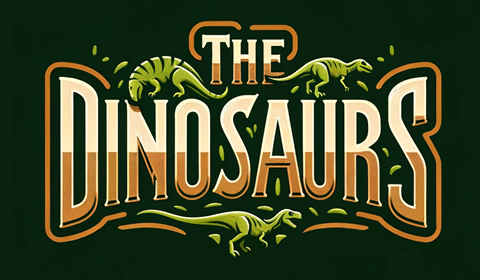Camptosaurus, a name derived from the Greek words ‘kamptos’ (bent) and ‘sauros’ (reptile or lizard) is a flagship member of Ornithopoda, a subclade of ornithischian dinosaurs that includes other famous alumni such Iguanodon and the duck-billed hadrosaurs. This herbivorous dinosaur, first unearthed in the rugged terrains of Albany County, Wyoming, in 1879, has since contributed to the vivid picture of life during the Late Jurassic. Its journey from discovery to scientific recognition is a tale that intertwines the dedication of early paleontologists with the ever-evolving field of paleontology.
Camptosaurus Key Facts
| Keyword | Fact |
|---|---|
| Pronunciation | KAMP-tu-SOR-us |
| Meaning of name | Flexible Lizard |
| Group | Ornithopod |
| Type Species | Camptonotus dispar |
| Diet | Herbivore |
| When it Lived | 155.7 to 145.0 MYA |
| Period | Late Jurassic |
| Epoch | Late/Upper Kimmeridgian to the top of the Early/Lower Tithonian |
| Length | 20 feet |
| Height | 6 to 8 feet |
| Weight | 1,700 to 1,900 pounds |
| Mobility | Moved on either two legs, or all four |
| First Discovery | 1879 by William Harlow Reed |
| Described by | 1885 by Othniel Charles Marsh |
| Holotype | YPM 1877 |
| Location of first find | Albany County, Wyoming |
| Also found in | Germany, Spain, Colorado, Oklahoma, South Dakota, Utah |
Camptosaurus Origins, Taxonomy and Timeline
Camptosaurus, a name that intriguingly translates to ‘Flexible Lizard’, is a prime example of the descriptive nature of scientific nomenclature. Combining ‘kamptos’ (bent) and ‘sauros’ (reptile or lizard), the name “Flexible Lizard” alludes to what its original describer considered the most remarkable aspect of its physiognomy: the lack of fusion between its sacral vertebrae – the sequence of spinal elements that make up the sacrum. This feature may have lent Camptosaurus a unique degree of flexibility at the hip, a characteristic that likely played a significant role in its survival and adaptability.
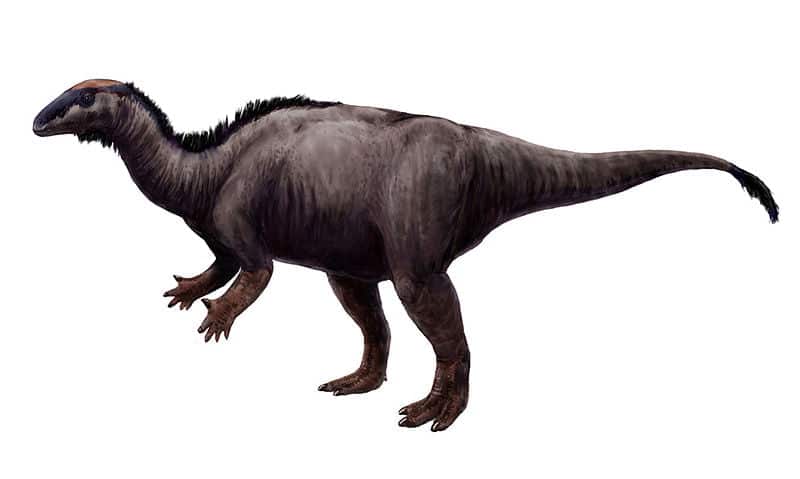
Camptosaurus is a member of the Ornithopod group of dinosaurs. In the technical language of modern cladistics, it is currently considered one of the earliest members of Ankylopollexia, a position that places it close to the ancestor of all duck-billed dinosaurs! This classification not only helps us understand its evolutionary relationships but also its ecological role during the Late Jurassic Period.
The timeline of this remarkable dinosaur spans a significant portion of the Late Jurassic Era, specifically from the Late/Upper Kimmeridgian to the Early/Lower Tithonian epochs. This places its existence approximately between 155.7 to 145.0 million years ago (MYA), a period marked by significant geological and biological changes.
Listen to Pronunciation
Check out this video to hear the correct pronunciation of ‘Camptosaurus’.
Discovery & Fossil Evidence
The discovery and classification of Camptosaurus have been a complex and evolving journey, marked by intriguing twists and reevaluations. It all began on September 4, 1879, when William Harlow Reed discovered the remains of a small euornithopod in Albany County, Wyoming. This find was initially described and named Camptonotus by Professor Othniel Charles Marsh, a name later changed to Camptosaurus due to a nomenclatural conflict.
Marsh’s early work in the 1870s and 1880s was foundational, with several species attributed to the Camptosaurus genus, including the type species C. dispar. However, many of these classifications were later revised. For instance, C. amplus, which was initially based on a foot that was later reassigned to Allosaurus.
The 20th century saw further reclassifications. Notably, in 1980, Peter Galton and H.P. Powell reevaluated the genus and concluded that species like C. nanus, C. medius, and C. browni were likely different growth stages or sexually dimorphic variants of C. dispar. This consolidation of species under C. dispar was a significant step in clarifying the genus’s taxonomy.
Additionally, several species initially classified under Camptosaurus were later reassigned to other genera. For example, C. depressus, found in South Dakota, was later moved to the genus Osmakasaurus, and C. aphanoecetes from Dinosaur National Monument was reclassified as Uteodon.
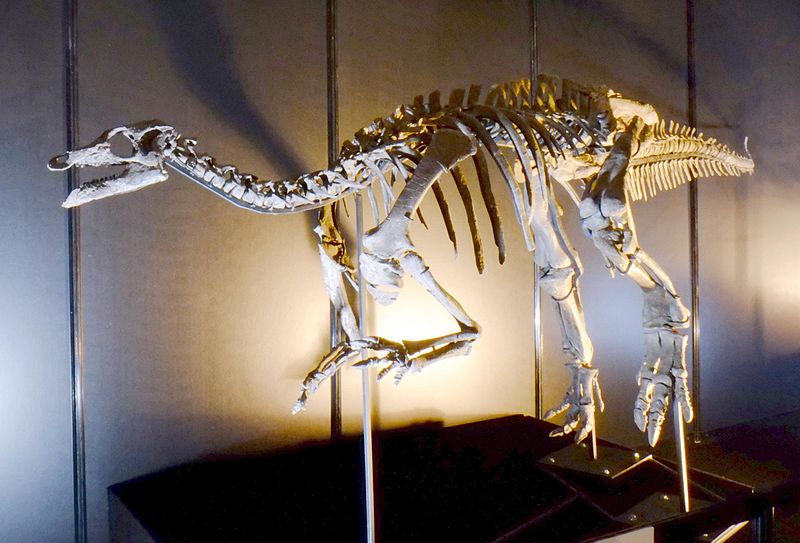 A whole-body skeleton of Camptosaurus in Japan.
A whole-body skeleton of Camptosaurus in Japan.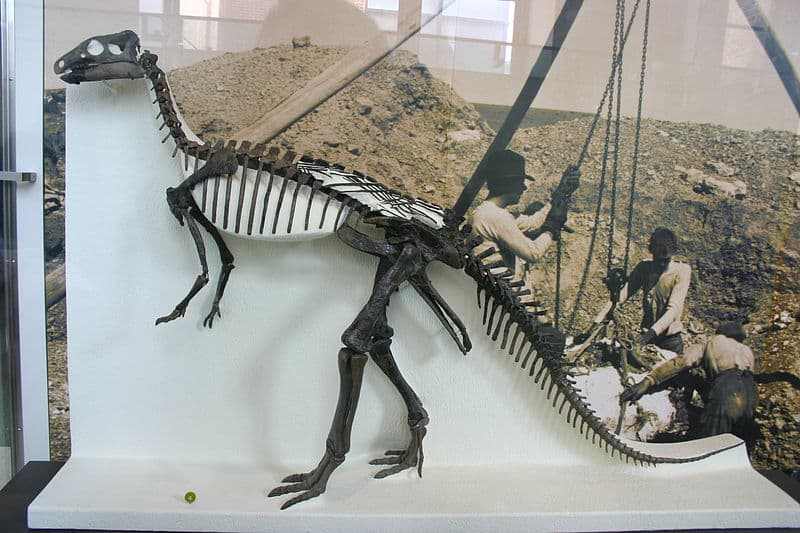 Outdated mount of a C. nanus skeleton at the AMNH, now thought to be a growth stage of C. dispar
Outdated mount of a C. nanus skeleton at the AMNH, now thought to be a growth stage of C. dispar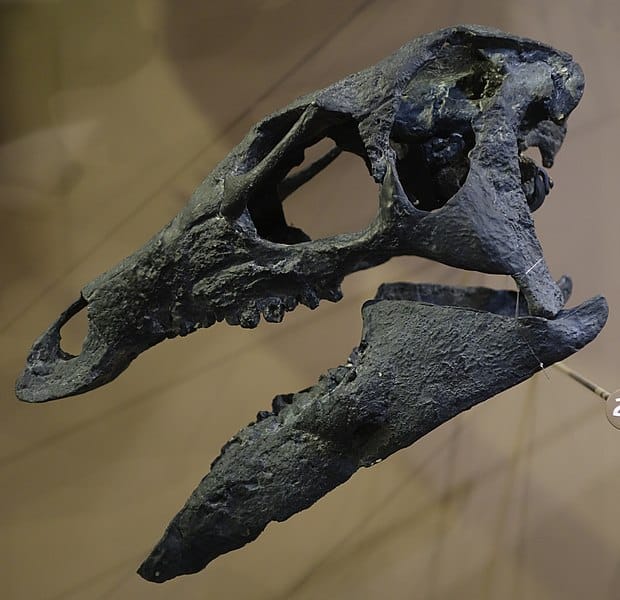 Cast of a skull from Bone Cabin Quarry West, Wyoming
Cast of a skull from Bone Cabin Quarry West, Wyoming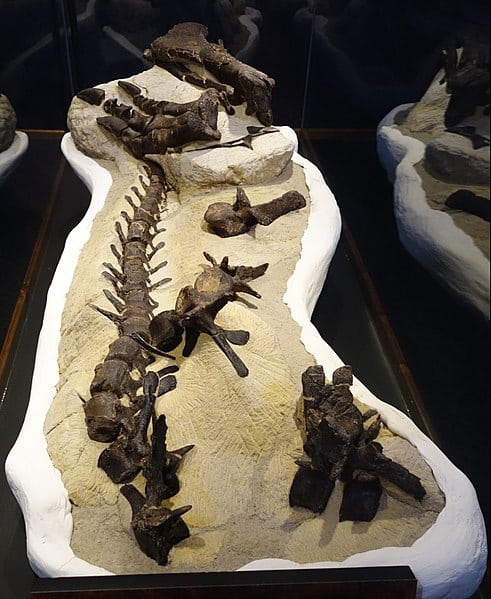 Camptosaurus specimen (original), on display at the Museum of Ancient Life, Utah.
Camptosaurus specimen (original), on display at the Museum of Ancient Life, Utah.
European Camptosaurus
Beginning in the late nineteenth century, a flurry of fossil-finding activity in Europe resulted in numerous species being assigned to Camptosaurus. However, many of these European species were later deemed invalid or reassigned to other genera, such as Callovosaurus and Owenodon. The case of Camptosaurus prestwichii is particularly notable. Initially described as Iguanodon prestwichii, it was later placed in its own genus, Cumnoria, and found to be more closely related to advanced Iguanodonts than to Camptosaurus dispar.
However, in 2022, a discovery in Spain renewed the case for a possible cosmopolitan distribution for Camptosaurus, with fragmentary remains indicating it may have been more geographically dispersed than previously thought. This ongoing journey of discovery and reclassification underscores the dynamic nature of paleontology, where each new find can reshape our understanding of these ancient creatures.
Camptosaurus Size and Description
Physically, Camptosaurus provided something of a generalized “blueprint” that later ornithopod evolution built-upon and developed further. Its body shape and structure was well-suited to its herbivorous lifestyle. The head of this dinosaur was distinct, equipped with a beak and teeth adapted for a plant-based diet. Its locomotion is particularly interesting; it could move on two legs or all four, suggesting a versatile and adaptable approach to movement and foraging. This ability to switch between bipedal and quadrupedal locomotion is indicative of a complex behavioral suite that was capable of adapting to various challenges on the fly, likely playing a crucial role in its ability to thrive in diverse environments and evade predators.
Size and Weight of Type Species
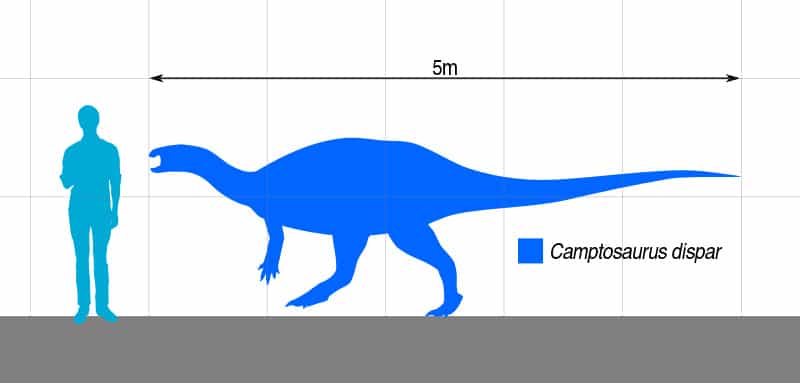
Camptosaurus, with its primitive retention of four toes, sturdy hindlimbs, and generalized locomotory strategy, clearly made for a striking presence in its Late Jurassic habitat. However, determining its exact size and weight has been a subject of ongoing research, especially in light of recent taxonomic revisions.
The most reliable estimates for Camptosaurus dispar, particularly those specimens from Quarry 13, suggest a sizable, but not overly gigantic dinosaur. These individuals, hailing from deep layers likely dating to the Callovian-Oxfordian, were moderately large. Adult specimens from this quarry are estimated to have reached about 20 feet in length. When it comes to weight, these individuals were quite hefty, with estimates ranging between 1,700 and 1,900 pounds.
However, larger fragments from later strata of the Morrison Formation hint at even bigger individuals, possibly reaching lengths of around 22 feet. This variation in size across different layers and specimens indicates a degree of diversity within the species.
In 2010, Gregory S. Paul provided a more conservative estimate, suggesting a length of approximately 16.4 feet and a weight around 1,100 pounds. This lower estimate adds another layer to our understanding of Camptosaurus’s physical dimensions, suggesting that while it was robust and heavily built, it might not have been among the largest of its contemporaries.
These size and weight estimates, though varied, paint a picture of a substantial if quietly impressive dinosaur.
Contemporary Dinosaurs
Camptosaurus, not too large nor too small, found itself in a world of both competition and coexistence. Picture this: Camptosaurus, roughly the size of a modern rhino, meandering through the ancient forests, its eyes always watchful. It shared its leafy world with the Uteodon, a fellow herbivore, similar in size but perhaps a bit bulkier. You can almost hear the rustling of leaves as these two peaceful giants grazed side by side, perhaps nudging each other playfully or competing gently for the tastiest ferns.
But life wasn’t all about peaceful grazing. Enter Torvosaurus, a fearsome predator, larger and more intimidating than our Camptosaurus. Imagine the tension in the air as Camptosaurus sensed this giant predator nearby. Torvosaurus, with its powerful jaws and sharp teeth, was a constant threat. Our Camptosaurus, though not defenseless, would have needed to rely on its keen senses and swift legs to escape these formidable hunters. The dynamics between them were like a dance – one of survival and instinct.
Then there was Tanycolagreus, smaller than our Camptosaurus, but no less menacing for it. This carnivore, agile and swift, might not have posed a direct threat to an adult Camptosaurus, but it certainly added to the complexity of their ecosystem. The interactions between them, though likely rare, would have been a display of agility and alertness, a testament to the survival skills of Camptosaurus.
Lastly, imagine the awe-inspiring sight of the long-necked Supersaurus, a giant even among dinosaurs, dwarfing our Camptosaurus. These towering creatures, larger than any animal walking the earth today, coexisted with Camptosaurus, likely causing no direct competition due to their sheer size and different dietary needs.
Interesting Points about Camptosaurus
- Versatile Locomotion: Camptosaurus could move on both two and four legs, a rare trait that highlights its adaptability.
- Late Jurassic Survivor: Living from 155.7 to 145.0 MYA, it witnessed significant geological and biological changes.
- Wide Geographical Spread: Fossils found in North America and Europe, indicating a broad distribution.
- Unique Diet Adaptations: Its beak and teeth were specialized for a herbivorous diet, reflecting its ecological niche.
- Fossil Discovery and Impact: First discovered in 1879, its fossils have significantly contributed to our understanding of Late Jurassic fauna.
Camptosaurus in its Natural Habitat
Imagine the world of Camptosaurus, a landscape that was both challenging and bountiful. This dinosaur thrived in an environment marked by diverse vegetation and changing climates, typical of the Late Jurassic Period. The geography ranged from lush forests to open plains, offering a variety of habitats. The climate was likely warm and humid, supporting a rich array of plant life, which was crucial for this herbivore.
The diet of Camptosaurus was purely herbivorous, consisting of the abundant vegetation of its time. Its unique dental structure, including a beak and specialized teeth, was perfectly adapted for feeding on a variety of plants. The ability to move on both two and four legs likely played a significant role in its foraging behavior, allowing it to reach different types of vegetation. This adaptability in locomotion also suggests that it could have had varied interactions with other species, whether evading predators or coexisting with other herbivores.
Camptosaurus’s role in its ecosystem was undoubtedly significant. As a large herbivore, it would have had a considerable impact on the vegetation and landscape, potentially shaping the environment around it. Its social behavior, whether as a solitary animal or part of a herd, would have influenced its survival strategies and interactions within its habitat. The study of this dinosaur not only illuminates its own life but also offers a window into the broader ecological dynamics of the Late Jurassic Period.
List of All Dinosaurs
We have created a list of all dinosaurs we have covered here, sorted across the seven main groups of dinosaurs. We also include information about their type of diet, (omnivore, herbivore or carnivore) and the time they lived.
Frequently Asked Questions
It was first discovered in 1879 by William Harlow Reed in Albany County, Wyoming.
Its name, Camptosaurus, translates to ‘Flexible Lizard’ from Greek.
This dinosaur was a herbivore, feeding on the abundant plant life of its time.
Yes, it had the unique ability to move on both two and four legs.
Fossils have been found in various locations including Germany, Spain, and several states in the USA.
It lived during the Late Jurassic Period, approximately 155.7 to 145.0 million years ago.
Sources
The information in this article is based on various sources, drawing on scientific research, fossil evidence, and expert analysis. The aim is to provide a comprehensive and accurate overview of Camptosaurus. However, please be aware that our understanding of dinosaurs and their world is constantly evolving as new discoveries are made.
Article last fact checked: Joey Arboleda, 11-29-2023
Featured Image Credit: FunkMonk (Michael B. H.), CC BY-SA 3.0, via Wikimedia Commons
